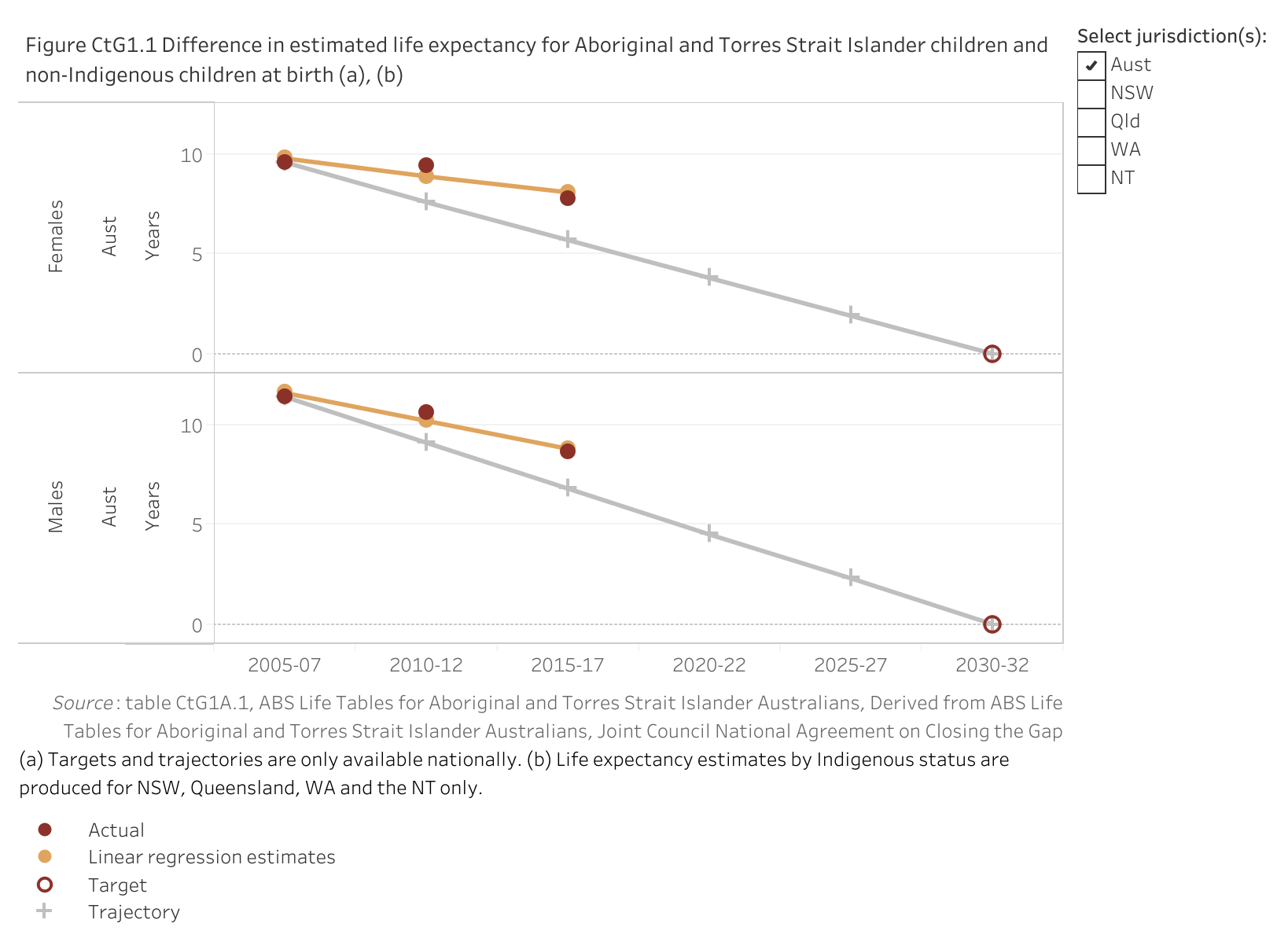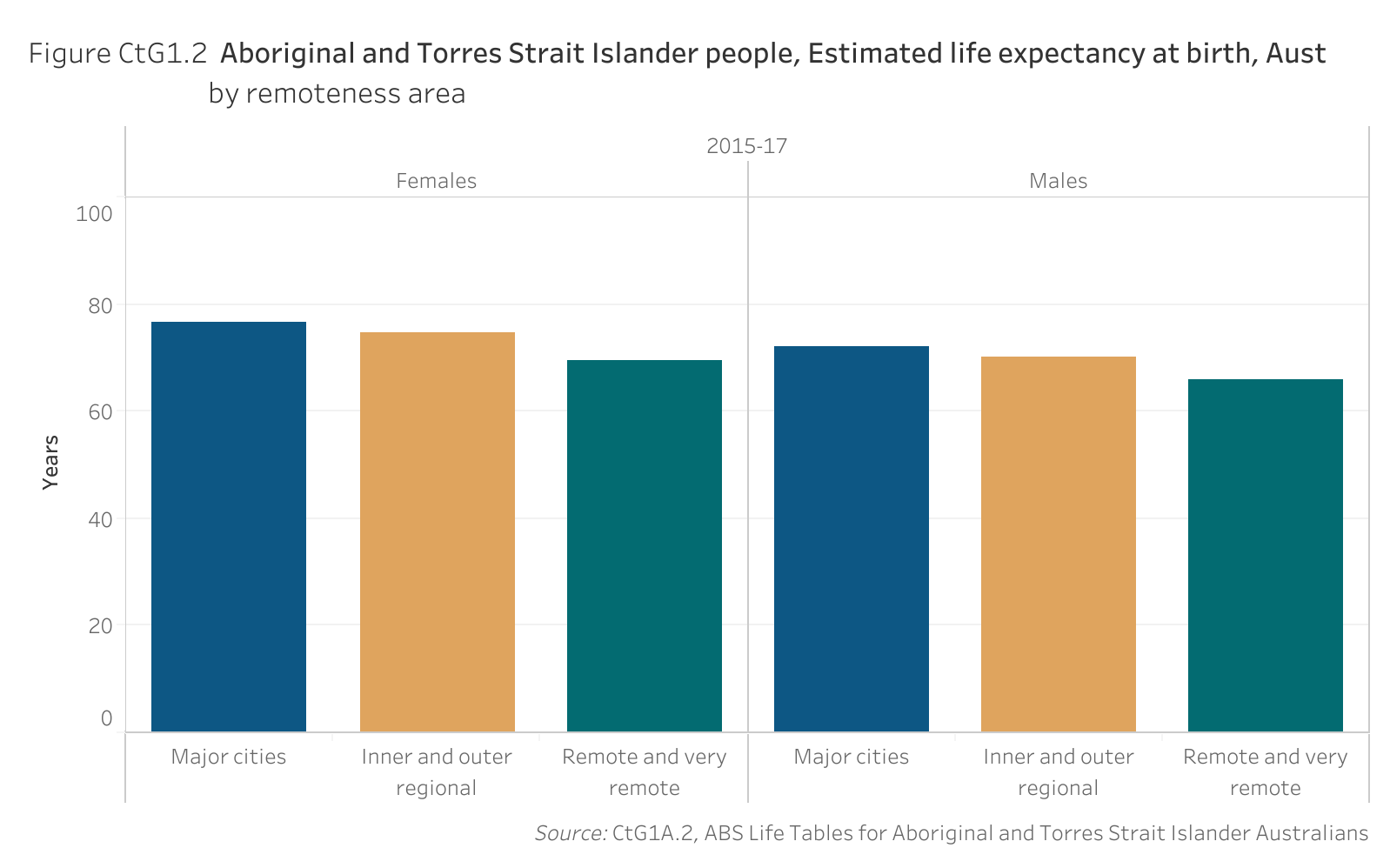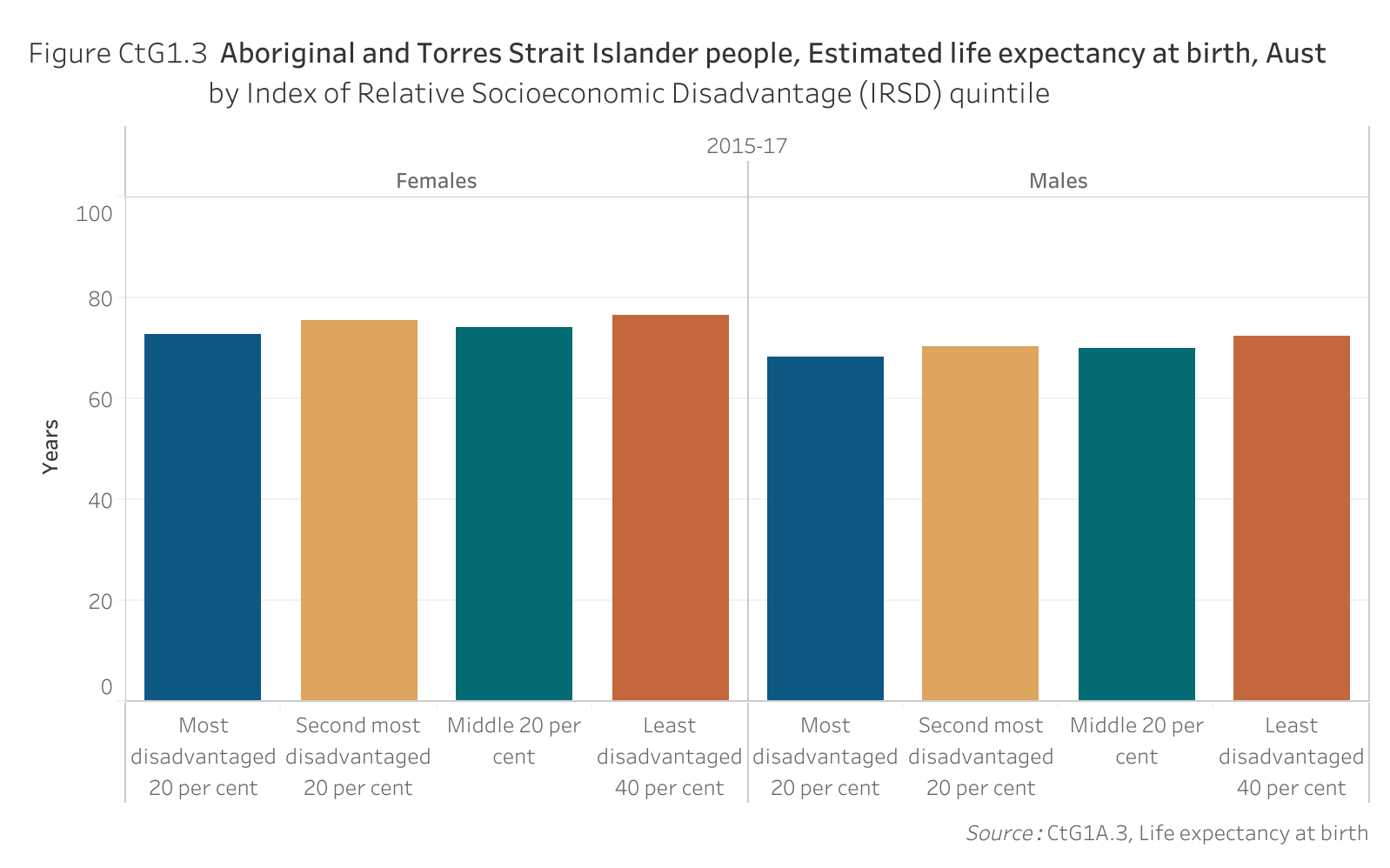Target 1
Close the Gap in life expectancy within a generation, by 2031.
Dashboard snapshot: The data below are the most recent at the time of preparing the July 2022 report. Please go to the dashboard to access the current data.
Nationally, Aboriginal and Torres Strait Islander males born in 2015–2017 are expected to live to 71.6 years and females to 75.6 years, and non-Indigenous males and females to 80.2 years and 83.4 years respectively (figure CtG1.1).
Between 2005–2007 and 2015–2017, the gap in life expectancy narrowed for males (from 11.4 years to 8.6 years) and for females (from 9.6 years to 7.8 years).
Nationally, based on progress from the baseline, the target shows improvement but is not on track to be met for males or females. However, this assessment should be used with caution as it is based on a limited number of data points. Please see the How to interpret the data page for more information.

| NSW | Vic | Qld | WA | SA | Tas | ACT | NT | Aust | |
|---|---|---|---|---|---|---|---|---|---|
| Male assessment | Not applicable as required data not available | Not applicable as required data not available | Not applicable as required data not available | Not applicable as required data not available | |||||
| Female assessment | Not applicable as required data not available | Not applicable as required data not available | Not applicable as required data not available | Not applicable as required data not available |
improvement
no change
worsening not applicable as required data not available.
good improvement and target on track to be met.
improvement but target not on track to be met.
Note: These assessments of progress should be used with caution as they are based on a limited number of data points.
Disaggregations
By remoteness area
Nationally, Aboriginal and Torres Strait Islander males and females born in 2015–2017 had higher life expectancy in major cities (72.1 years and 76.5 years, respectively) and regional areas (70.0 years and 74.8 years, respectively), than in remote and very remote areas (combined) (65.9 years and 69.6 years, respectively) (figure CtG1.2).

| 2015-17 | ||
|---|---|---|
| Females | Males | |
| Remote and very remote | 69.6 | 65.9 |
| Inner and outer regional | 74.8 | 70.0 |
| Major cities | 76.5 | 72.1 |
By Index of Relative Socioeconomic Disadvantage (IRSD) quintile
Nationally in 2015–2017, Aboriginal and Torres Strait Islander males and females born in the least disadvantaged socioeconomic areas had higher life expectancy (72.4 years and 76.6 years, respectively) compared to those born in the most disadvantaged areas (68.2 years and 72.8 years, respectively) (figure CtG1.3).

| 2015-17 | ||
|---|---|---|
| Females | Males | |
| Least disadvantaged 40 per cent | 76.6 | 72.4 |
| Middle 20 per cent | 74.3 | 69.9 |
| Second most disadvantaged 20 per cent | 75.5 | 70.3 |
| Most disadvantaged 20 per cent | 72.8 | 68.2 |
Target data specifications
Outcome: |
Aboriginal and Torres Strait Islander people enjoy long and healthy lives. |
|---|---|
Target: |
Close the Gap in life expectancy within a generation, by 2031. |
Indicator: |
Life expectancy gap. |
Measure: |
This measure is defined as the difference between Aboriginal and Torres Strait Islander people and non-Indigenous life expectancy. Life expectancy is the average number of years that a newborn baby could expect to live, if they experienced the age/sex specific death rates that applied at their birth throughout their lifetimes. |
Target established: |
National Agreement on Closing the Gap July 2020 |
Latest dashboard update: |
31 March 2022 |
Indicator type: |
Target |
Interpretation of change: |
A higher or increasing life expectancy for Aboriginal and Torres Strait Islander people and narrowing of the gap in life expectancy with non-Indigenous people is desirable. |
Data source(s): |
Name: ABS Life Tables for Aboriginal and Torres Strait Islander Australians Frequency: Five-yearly Documentation (links): https://www.abs.gov.au/statistics/people/aboriginal-and-torres-strait-islander-peoples/life-tables-aboriginal-and-torres-strait-islander-australians/ |
Data provider: |
Provider name: Australian Bureau of Statistics Provider area: Demography |
Baseline year: |
2006 (3-year average of 2005-2007) |
Latest reporting period |
2016 (3-year average of 2015-2017) |
Target year: |
2031 (3-year average of 2030-2032) |
Disaggregations: |
Selected states and territories and Australia, by Indigenous status, by sex. Australia, by remoteness area, by Indigenous status, by sex. Australia, by Indigenous status, by Index of Relative Socioeconomic Disadvantage (IRSD), by sex. |
Computation: |
Counting rules Direct estimation of the life expectancy gap at birth between Aboriginal and Torres Strait Islander and non-Indigenous people using the average number of deaths registered in the relevant three-year period and the estimated resident population (ERP) at the mid-point of that 3-year period, with adjustments for incomplete identification by Indigenous status. The Australian headline life expectancy estimates are calculated taking age-specific identification rates into account. The Australian total includes all states and territories (including Other Territories). Disaggregations: The data on deaths used to estimate life expectancy at birth by geographic area are based on usual residence of the deceased. Sex relates to biological primary sexual characteristics. Remoteness area is classified according to the ABS 2016 Australian Statistical Geography Standard (ASGS) using SA2 as the building block. Life expectancy for people whose location of usual residence is either (1) categorised as ‘migratory’ or (2) not sufficient to identify their geographic area and assign remoteness area are excluded from the analysis by remoteness. Socioeconomic status of the locality is classified according to the Socio-Economic Indexes for Areas (SEIFA): Index of Relative Socio-economic Disadvantage (IRSD), 2016 using SA2 as the building block. Data are reported by IRSD quintile that are determined at the Australian level. Life expectancy for people whose location of usual residence is either (1) categorised as ‘migratory’ or (2) not sufficient to identify their geographic area and assign a socioeconomic status of the locality are excluded from the analysis by socioeconomic status. Supporting calculations The difference in life expectancy estimates between Aboriginal and Torres Strait Islander and non-Indigenous people, and confidence intervals (upper and lower limits). Confidence intervals are only available for estimates for Aboriginal and Torres Strait Islander people. Calculation of differences are based on unrounded estimates. |
Data quality considerations: |
Aboriginal and Torres Strait Islander and non-Indigenous life tables are based on ERP (ABS 2017) (based on the Census of Population and Housing and the Census Post Enumeration Survey), death registration information provided by the State/Territory Registrars of Births, Deaths and Marriages, and the ABS Census Data Enhancement Indigenous Mortality Quality Study. Life expectancy estimates by Indigenous status are produced for NSW, Queensland, WA and the NT only. These estimates are calculated without taking age-specific identification rates into account. Aboriginal and Torres Strait Islander estimates of life expectancy are not produced for Victoria, SA, Tasmania and the ACT due to the small number of Aboriginal and Torres Strait Islander deaths reported in these jurisdictions. Caution is required when interpreting trends in life expectancy estimates, because of changes in Indigenous identification across data collection and over time, and variation across geographies and socioeconomic groups. The estimates by remoteness and IRSD are calculated without taking age-specific identification rates into account. |
Future reporting: |
Additional disaggregations required for future reporting:
|
Supporting indicators
Driver
- All-cause mortality
- Leading causes of death
Infant mortality, child mortality, and five-yearly age groups
- Potential avoidable mortality rates
- Prevalence rates of health risk factors
Smoking, alcohol and drug use, overweight and obese, dietary factors, physical activity
- Rates of accessing/utilisation of health services
General Practitioner (GP) visits, health assessments (Medicare Benefit 715), chronic disease care items (Team Care arrangement and GP Management Plan)
Contextual information
- Hospitalisation rates by leading causes
- Discharge against medical advice
- Burden of disease from socioeconomic factors
Material for download
- People enjoy long and healthy lives data tables (XLSX - 42 Kb)
- People enjoy long and healthy lives dataset (CSV - 94 Kb)
To assist with interpretation of the data provided (Excel data tables and CSV dataset) please refer to the target data specification (above) and the indicator data specifications (provided in each supporting indicator page – linked above).
